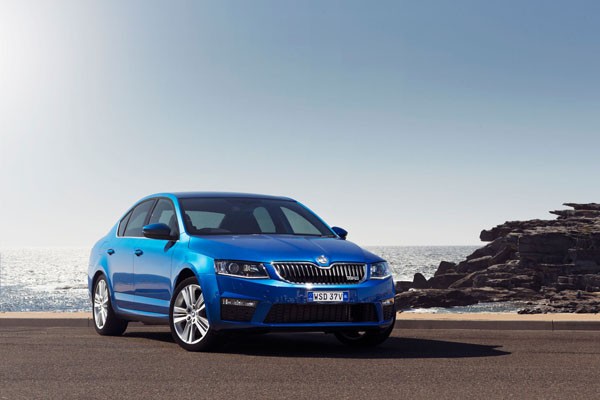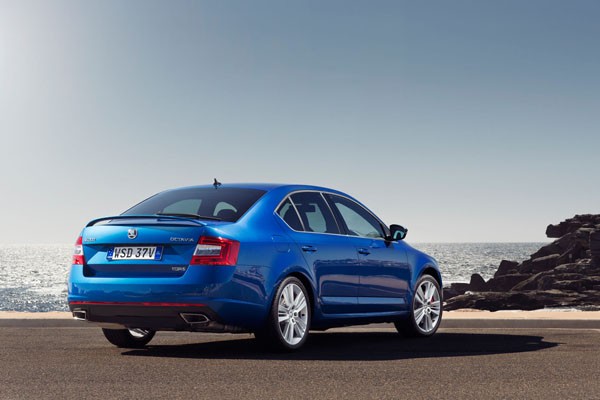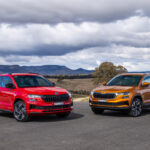
Question: when is it not bad form to mention the phrase ‘performance enhancement’ in the same breath as the Tour de France bike race? Answer: when talking about Skoda.
The VW Group owned, Czech based automobile manufacturer recently re-signed as the official partner of the cycle race at the same time as launching its Octavia RS high-performance sedan in Australia.
The RS designation stands for ‘RallySport’, and celebrates its 40th anniversary this year.
The Skoda Octavia RS is simply the quickest production Octavia of all time with a zero to 100 km/h sprint time of 6.8 seconds for the petrol powered sedan version.
 ENGINES / TRANSMISSIONS
ENGINES / TRANSMISSIONS
The third generation RS comes in sedan and wagon form with the choice of two engines, a 162 kW 2.0-litre petrol or 135 kW 2.0-litre diesel unit.
The new engines produce up to ten per cent more power than those of the previous model while saving up to 17 per cent in fuel when measured to the official standards. That low consumption is in part due to brake energy recuperation.
The petrol engine is hooked up to either a six-speed manual or DSG dual-clutch transmission, while the diesel is available only with the six-speed DSG.
CHASSIS
Sports suspension, progressive steering and XDL differential lock are all standard.
As befits such a sports oriented vehicle, the latest Octavia RS offering is 12 mm lower in the sedan and 13 mm the wagon, than the standard Octavia.
As well as the lower body, the RS is longer (85 mm, sedan; 88 mm, wagon) and 45 mm wider than its predecessor. Wheelbase is up by 102 mm. These come in tandem with a shortened front overhang and standard red brake calipers, which only add to the vehicle’s powerful stance.
STYLING
In looks the vehicle stands apart from the standard Octavia with a distinctive radiator grille, honeycomb air inlets, a new apron, RS fog lights and bi-xenon headlamps with integrated LED daytime running lights.
The standard Octavia RS comes with silver 18-inch Pictoris alloy wheels and 225/40 R18 tyres. Customers after even sportier rims can choose the 18-inch Gemini or 19-inch Xtreme alloy rim in sporting black.
Six colours are available for the exterior including the new solid Steel Grey which is exclusive to the RS.
INTERIOR
More space has found its way inside both sedan and wagon variants. There is more cabin length (1782 mm) and more legroom (73 mm), while sedan boot volume has grown by eight litres to 568 litres. With 588 litres, the wagon offers even more storage space.
Occupants are coddled in RS sport seats trimmed in standard fabric and leather combination, or optional Alcantara with red contrast stitching. The RS sports a three-spoke steering wheel with perforated leather and an instrument cluster with a colour multifunction display.
Further reminders of the car’s exclusivity come with the RS insignia posted on the steering wheel, gearshift, door sills, seats, and floor mats, while clever touches come with standard features including door storage incorporating a rubbish bin with disposable plastic bag, a holder for a range of mobile phones and portable media players and a flip-over double-sided boot floor mat.
SAFETY
Octavia RS earns a maximum five-star ANCAP safety rating. Passengers are protected by a rigid vehicle body, nine airbags, brake with automatic braking action following a crash; Passenger Protect Assist and Fatigue Detection. Front Assist with emergency braking is part of the optional Tech Pack.
INFOTAINMENT
The standard Columbus radio / navigation system uses an 8-inch high resolution touch screen with proximity sensors activated when a hand approaches the screen.
A DVD player takes the place of the CD player, media connection including Apple video function, menu guidance, 2 SD card slots, Bluetooth high-end telephone function, voice control, a JPEG viewer and an internal 64GB flash memory.
A multi-drive mode select system, already in the standard Octavia, will be available in the RS from April. An optional Tech Pack, on offer mid-year, includes Canton premium 10-speaker sound system and rear-view camera.
Options include full leather seats, chrome window frames, electric sunroof and automatic tailgate on the wagon.
DRIVING
On a hit-out in the Snowy Mountains to launch the Octavia RS in Australia both sedan and wagon put on an exhibition of power and agility of Olympic proportions.
The 162 kW of petrol power put to ground through a six-speed manual transmission gobbled up the going with unparalleled speed and stability, all with a sporty engine note to match. Minor cabin intrusions included road noise on coarser surfaces and some wind flutter around the exterior mirrors.
A 135 kW diesel wagon with six-speed DSG at its service likewise turned out to be a smooth operator, although the 380 Nm of maximum torque did tend to fade beyond 3500 revs.
Average fuel consumption was clocked at 9.6 litres per 100 kilometres for the petrol manual and 7.8 litres per 100 kilometres from the diesel DSG automatic with some particularly energetic action.
The Octavia RS comes on to the market in April keenly priced from $36,490 for the TSI petrol manual sedan, topping out at $39,790 for the DSG version. The wagons attract a $1350 premium.
MODEL LINE-UP
Octavia RS 162 TSI 2.0-litre petrol four-door sedan: $36,490 (manual), $38,790 (DSG automatic)
Octavia RS 135 TDI 2.0-litre diesel four-door sedan: $39,790 (DSG automatic)
Octavia RS 162 TSI 2.0-litre petrol five-door wagon: $37,840 (manual), $40,140 (DSG automatic)
Octavia RS 135 TDI 2.0-litre diesel five-door wagon: $41,140 (DSG automatic)
Note: These prices do not include government or dealer delivery charges. Contact your local Skoda dealer for driveaway prices.










